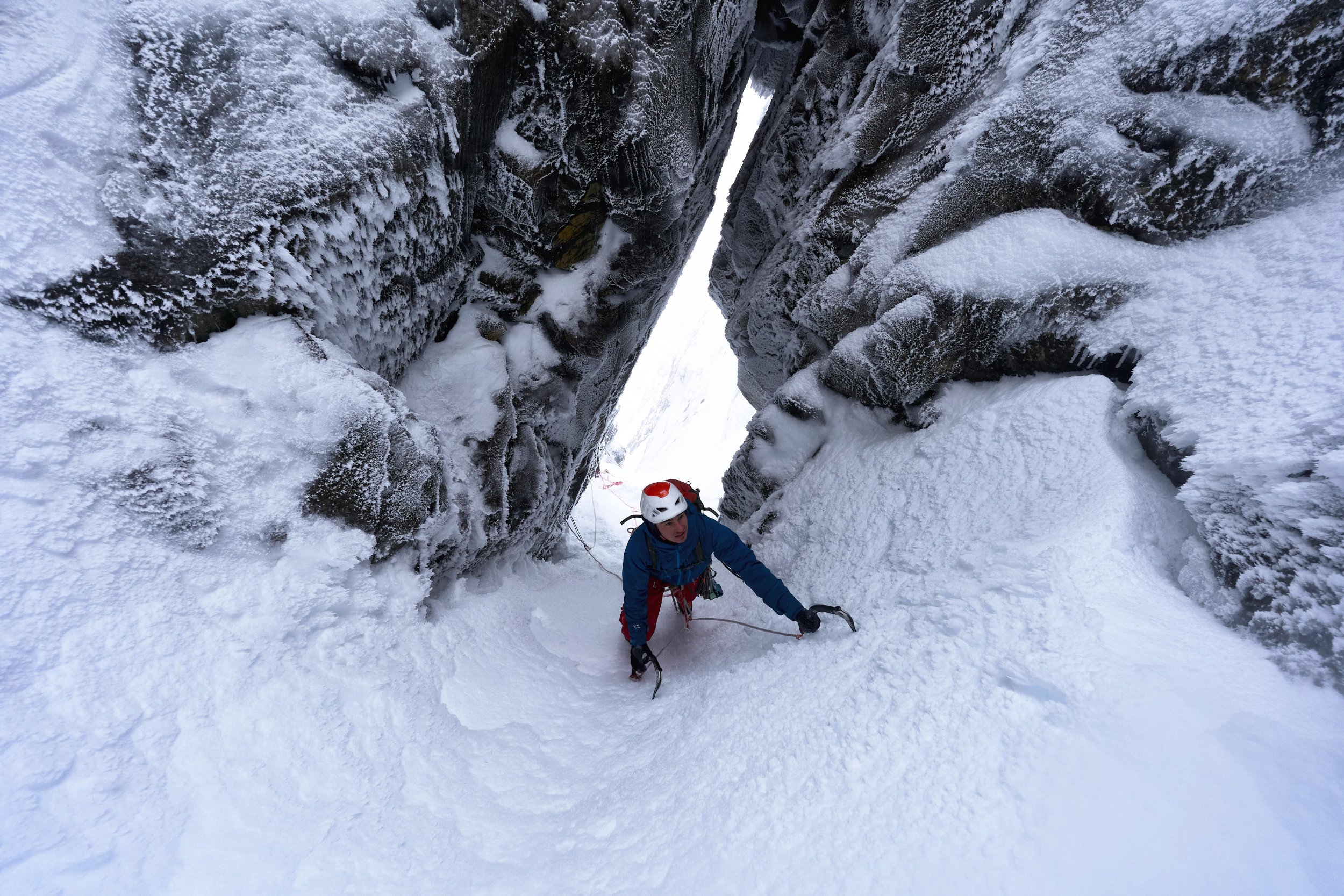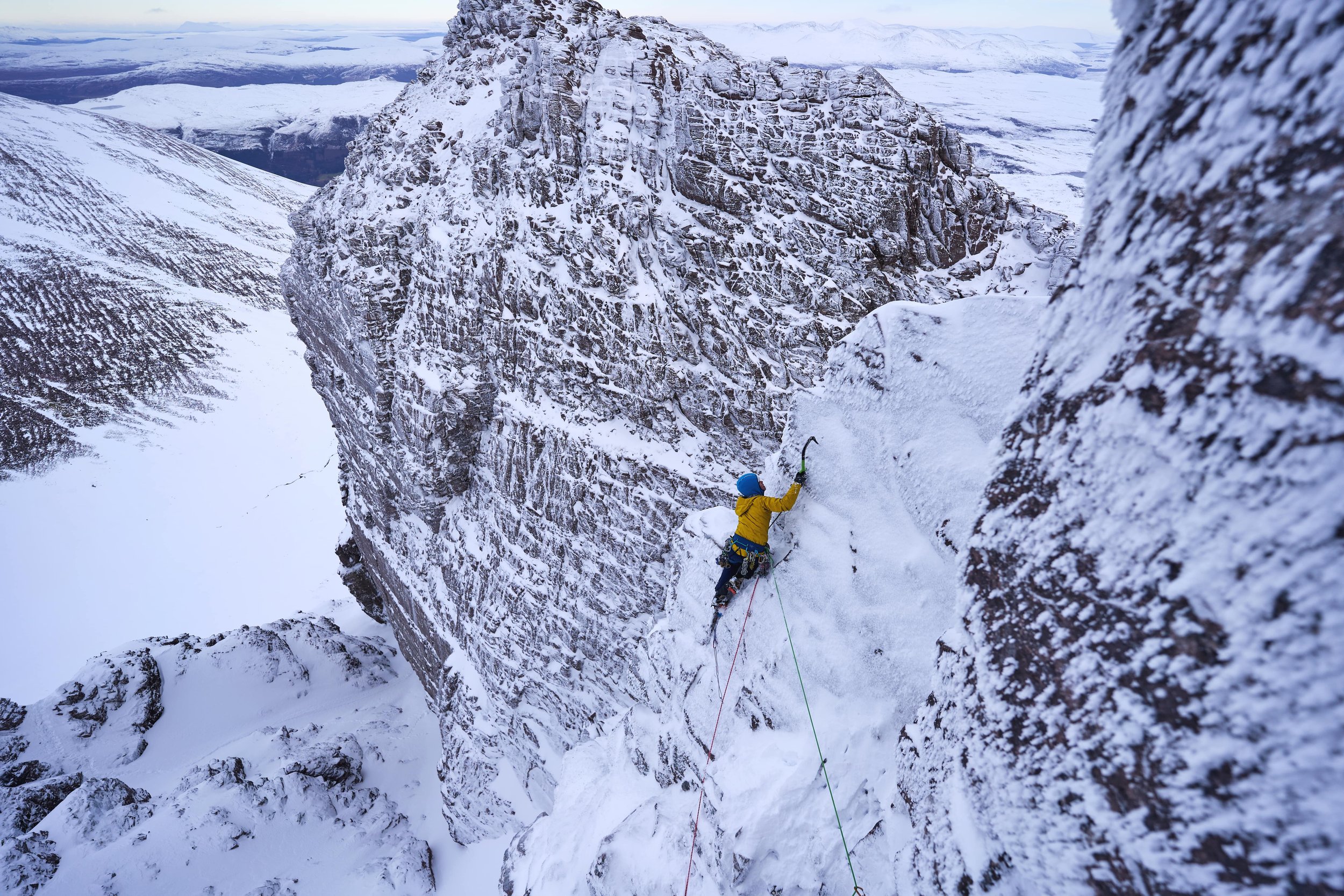Over the course of last winter, I worked on a project in collaboration with GORE-TEX, Jamie Skelton, Ella Wright and Tim Miller, putting a range of GORE-TEX Pro kit through its paces over the course of a Scottish winter season. When it comes to testing kit, I don’t think you get a much higher bar than Scotland in winter. Going out in all sorts of wild weather, grovelling up thrutchy mixed chimneys, and sweaty walk-ins carrying heavy packs full of climbing gear. The clothing you wear needs to keep you dry to give you every chance of succeeding in this tough environment.
Jamie Skelton on the wildly overhanging third pitch of ‘Hung, Drawn and Quartered’ VIII 8, on Am Basteir
Aside from a brief spell of good conditions prior to Christmas, the winter of 2020/21 began slowly. January was warm, with little snow on the hills and not much in the way of conditions for winter climbing. Eager to get started on the project, early season patience gradually wearing thin, until finally a cold storm arrived at the end of the month. Myself, Jamie and Tim headed up to the cliffs high above Number 3 Gully on Ben Nevis. As snowed up rock routes these usually come into condition fairly quickly after a storm.
From afar during the approach, things didn’t look promising. There had been less snowfall than expected and much of the Coire was looking black and out of condition. In Scottish winter climbing there is a set of ethics which determine whether a route is in acceptable winter condition (largely to stop people scratching their way up rock routes in summer with ice axes and crampons, but also because an important part of the challenge of doing a route in winter is dealing with rime and icy rock and thus having some rules is important to ensure a fair winter ascent). Routes are expected to have some rime of snow on them, or to be icy enough that an ascent wouldn’t be possible with bare hands and rock shoes in order to be considered in fair winter condition. We ventured higher into Coire na Ciste, hoping that things might be more promising higher on the cliffs. Our persistence paid off.
Jamie Skelton finishing the delicate traverse on ‘Babylon’ VII 7
Babylon, a route at the highest point on Number 3 Gully Buttress, was covered in a thin layer of rime ice. Just enough to be in fair nick. The route follows a system of cracks up to an outrageously positioned top pitch. A thin traverse, with wild exposure below you, leads to the foot of a wide chimney. A couple of big moves and you’re into the chimney itself and using your entire body to bridge and thrutch your way up to the top of the cliff. The pitch was almost a perfect test of some of the key aspects of the GORE-TEX kit. Its ability to move well with the climbers as they made the big moves into the chimney, and then also its durability and abrasion resistance as they used full body friction to make their way up the chimney itself.
Jamie Skelton pulling into the upper chimney on ‘Babylon’ VII 7
Tim Miller putting the abrasion resistance of the GORE-TEX Pro fabric to good test
Topping out on the route with time in hand, we took a wander up to near the summit of the Ben. Seeing that Gardyloo Gully was in great early season icy condition, Jamie and Tim quickly romped up the atmospheric gully, allowing us to capture some ice climbing imagery. A nice bonus from the day!
Tim climbing beneath the big chockstone in Gardyloo Gully, high on Ben Nevis
February brought more storms, and our attention turned to some of the more out there winter climbing locations in Scotland. Tim ramped up the ambition levels further, having seen a recent photo online which suggested that a route called ‘Hung, Drawn & Quartered’ on the Isle of Skye may be in condition. Situated on the sharp pinnacle of Am Basteir on the Cuillin Ridge, the route is a modern classic which sees relatively few ascents. It follows an overhanging basalt dyke line which cuts through the steepest section of the cliff. Upward progress is made by hooking your axes over chock-stones (which have fallen and wedged themselves into cracks in the rock), with a bit of chimney grovelling thrown in for good measure.
‘Hung, Drawn and Quartered’ VIII 8, on Am Basteir. The climb follows the overhanging basalt dyke which runs up the cliff
As spindrift whips around the cliff, Jamie makes the final moves to the belay on the third pitch of ‘Hung, Drawn and Quartered’
This was one of the highlight days of the entire winter for all of us, Jamie and Tim both agreeing that it was one of the best Scottish winter routes they’d climbed. Although a little part of me was gutted not to get to climb it myself, I enjoy days like this with a camera in hand as much as the days hanging off a pair of axes. Stormy conditions (a drone crash..), some complex access and rigging to get into the top of the route, and an incredibly photogenic line at the end of it. It gave everything I really look for in a day out shooting winter climbing.
The breathtaking An Teallach ridgeline
After getting down from Am Basteir and refuelling on pizza in Broadford, we decided to make the most of the good conditions and head straight up to the Northwest Highlands for another day out. Tim had other commitments, but Ella was free so she drove up to join us. An Teallach is one of the most iconic mountains in Scotland, its jagged ridgeline almost resembling a sleeping stegosaurus. One of (if not the best) winter playgrounds in Scotland, the gullies provide excellent steep skiing and the blocky, vegetated sandstone which makes up the cliffs, freezes to offer excellent winter climbing. That morning, we set off through the infamous maze of thick Rhododendron woods that mark the start of the route in. High hopes for an adventurous day ahead, we were hoping to climb a line on Lord Berkley’s Seat, a steep prow of sandstone midway along the ridge. The approach involved ascending a steep snow gully, however as we began up the gully it quickly became apparent that a lot more snow had fallen here than on Skye and more worryingly there was a weak layer sitting beneath all of this fresh snow. As a large hulk of a mountain, sitting way out on its own near the sea, An Teallach can get large amounts of snowfall. Any incoming weather from the Atlantic, hits this vast mass of rock and deposits any precipitation it carries. It was clear that reaching our planned objective was going to be unfeasible with the deep and unstable snowpack, so plans were adapted and we improvised a plan to get some photos on a more accessible section of cliff. Although it wasn’t the plan we’d initially hoped for, we came away with some good images of Ella on some likely unclimbed ground in an impressive position high above Hayfork Gully. One thing I’ve learnt over my time photographing and climbing in the Scottish winter is that things don’t always go to plan, and although you can spend lots of time analysing weather forecasts and snow reports, you don’t always get it right! It’s crucial to never be too wedded to a plan, and to know when you need to change tack and come up with a plan B (or C or D!).
Ella Wright climbing high above Hayfork Gully on An Teallach
For the final day of the project, much later in the season, we headed back to where it all began, Ben Nevis. Ben Nevis is particularly famous for its late season ice. Many of these are long face routes which form due to regular freeze thaw cycles on the mountain. These differ in character to waterfall ice often climbed elsewhere in the world. A common feature of these routes is a unique kind of chewy, plastic ice, which is brilliant to climb although often not so brilliant to protect, with ice screws seldom inspiring much confidence!
Jamie leading the first pitch of ‘Five Finger Discount’ IV 4 on Ben Nevis
Ella on pitch two
A big part of the project was also highlighting the wash, care and repair methods which can seriously prolong the life of GORE-TEX kit. Many people choose to retire their shell jackets and trousers once they begin to lose water repellency. By using wash and reproofing products, such as those offered by Grangers, it’s possible to give GORE-TEX fabric a completely new lease of life. This is not only good for your wallet but also for the planet! We used a variety of Grangers products, such as the Performance Wash and the Performance Repel Plus to keep the kit performing at its best through the winter, along with GORE-TEX fabric patches to repair the occasional nick or tear in the clothing.
Reproofing one of the jackets
Patching up a small nick in the fabric
As to how the kit performed throughout the winter, I’d generally judge the performance of your winter shell relatively passively. What I mean by this is that it doesn’t need to do anything flashy or exciting, it should just be reliable and perform. The only times you should actually be aware of how it’s performing is when it lets you down and isn’t doing what it should be. You only notice a jacket isn’t breathable when you’re damp with sweat during a period of exertion. You only notice it’s not waterproof when it’s heavily raining or snowing and you’re no longer dry inside. You only notice it’s not stretching when your freedom of movement is restricted whilst making a big climbing move. You only notice it’s not durable when it tears on a sharp rock. Although no jacket or material is totally perfect in any of these regards, GORE-TEX performs exceptionally well on the whole. It allows you to go out and climb in often incredibly challenging conditions. The vast majority of the time you don’t notice what it’s doing, but when you think about it, it’s doing a quite exceptional job keeping you dry and protected from the elements. It very rarely lets you down and that’s the reason why it’s the go-to for the majority of people who climb in the Scottish mountains during the winter months.













